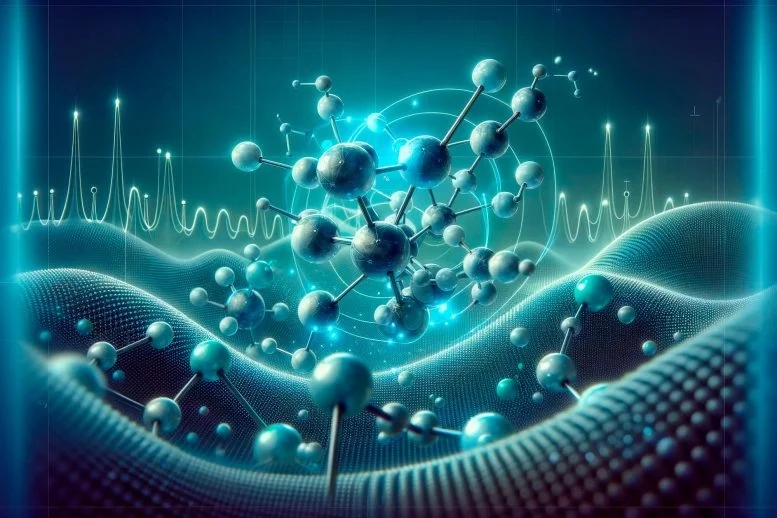博文
科学家重写分子规则,电子静止不动
 精选
精选
||
科学家重写分子规则,电子静止不动
诸平
据英国剑桥大学(University Of Cambridge, Cambridge, UK)2024年5月20日提供的消息,科学家重写分子规则,电子静止不动(Electrons Stand Still As Scientists Rewrite Molecular Rules)。
通过基于激光的光谱学技术发现的新分子设计规则使电子从原子振动中解耦,从而显著提高了有机发光二极管(Organic Light-Emitting Diodes简称OLEDs)和生物医学成像等应用的性能。
自从100多年前发现量子力学以来,人们已经知道分子中的电子可以与组成分子的原子的运动相耦合。通常被称为分子振动,原子的运动就像微小的弹簧,经历周期性的运动。
对于这些系统中的电子来说,与这些振动结合在一起意味着它们也在不断地运动,随着原子的曲调跳舞,时间尺度是十亿分之一秒的百万分之一。但是,所有这些翩翩起舞会导致能量的损失,并限制了有机分子在发光二极管(OLEDs)、红外传感器和用于细胞研究和标记疾病(如癌细胞)的荧光生物标志物等应用中的性能。
分子设计的突破(Breakthrough in Molecular Design)
现在,研究人员利用基于激光的光谱技术发现了新的分子设计规则,能够阻止这种分子舞蹈。他们的研究结果2024年5月8日已经在《自然》(Nature)杂志网站发表——Pratyush Ghosh, Antonios M. Alvertis, Rituparno Chowdhury, Petri Murto, Alexander J. Gillett, Shengzhi Dong, Alexander J. Sneyd, Hwan-Hee Cho, Emrys W. Evans, Bartomeu Monserrat, Feng Li, Christoph Schnedermann, Hugo Bronstein, Richard H. Friend, Akshay Rao. Decoupling excitons from high-frequency vibrations in organic molecules. Nature, 2024, 629: 355–362. DOI: 10.1038/s41586-024-07246-x. Published: 08 May 2024. https://www.nature.com/articles/s41586-024-07246-x
参与此项研究的除了来自英国剑桥大学的研究人员之外,还有来自美国国家航空航天局(NASA)艾姆斯研究中心(NASA Ames Research Center, Moffett Field, CA, USA)、美国劳伦斯伯克利国家实验室(Lawrence Berkeley National Laboratory, Berkeley, CA, USA)、中国吉林大学(Jilin University, Changchun, China)以及英国斯旺西大学(Swansea University, Swansea, UK)的研究人员。
此项成果揭示了关键的设计原理,可以阻止电子与原子振动的耦合,实际上是关闭它们的狂热舞蹈,推动分子达到无与伦比的性能。
该研究的第一作者、圣约翰学院(St John’s College)的成员、剑桥大学卡文迪什实验室的博士生普拉图什·高什(Pratyush Ghosh)说:“所有的有机分子,比如在活细胞或手机屏幕中发现的那些有机分子,都是由通过化学键相互连接的碳原子组成的。这些化学键就像微小的振动弹簧,通常会被电子感觉到,从而削弱分子和设备的性能。然而,我们现在发现,当我们将分子的几何和电子结构限制为某些特殊构型时,某些分子可以避免这些有害影响。”
为了证明这些设计原理,科学家们设计了一系列高效的近红外发射(680-800纳米)分子。在这些分子中,能量损失是由振动引起的,本质上,电子随着原子的音调跳舞,比以前的有机分子低100多倍。这种对设计发光分子的新规则的理解和发展为未来开辟了一条非常有趣的轨迹,这些基本观察结果可以应用于许多行业。
潜在应用和未来方向(Potential Applications and Future Directions)
“这些分子在今天也有广泛的应用。现在的任务是将我们的发现转化为更好的技术,从强化显示到改进的分子用于生物医学成像和疾病检测,”领导这项研究的卡文迪什实验室的阿克沙伊·拉奥(Akshay Rao)教授总结道。
该项目得到了欧洲研究理事会在欧盟地平线2020研究和创新计划{European Research Council under the European Union’s Horizon 2020 research and innovation programme Grant Agreement No. 101020167 (SCORS) and Grant Agreement No. 758826 (SOLARX)}、英国工程和物理科学研究委员会{Engineering and Physical Sciences Research Council简称EPSRC (UK) grant no EP/S003126/1;Grant No. EP/P020259/1}、西蒙斯基金会{Simons Foundation (Grant No. 601946)}、剑桥信托基金(Cambridge Trust)及乔治和莉莲希夫基金会(George and Lilian Schiff Foundation)提供的博士奖学金、剑桥圣约翰学院(St John’s College, Cambridge)、玛丽-居里学者(Marie Skłodowska-Curie Actions Grant Agreement No. 891167)、中国国家自然科学基金(National Natural Science Foundation of China Grant No. 51925303)、欧盟的地平线2020项目{European Union’s Horizon 2020 project for funding under its research and innovation programme through Marie Skłodowska-Curie Actions (Grant Agreement No. 859752, HEL4CHIROLED)}、英国研究与创新未来领袖奖学金{Future Leaders Fellowship from UK Research and Innovation (UKRI; Grant No. MR/V023926/1)}、吉安娜·安杰洛普洛斯科学、技术和创新项目(Gianna Angelopoulos Programme for Science, Technology, and Innovation)、温顿可持续发展物理学计划(Winton Programme for the Physics of Sustainability)以及利华休姆信托基金的早期职业奖学金(Leverhulme Trust for an Early Career Fellowship ECF-2022-445)的资助。
上述介绍,仅供参考。欲了解更多信息,敬请注意浏览原文或者相关报道。
The coupling of excitons in π-conjugated molecules to high-frequency vibrational modes, particularly carbon–carbon stretch modes (1,000–1,600 cm−1) has been thought to be unavoidable1,2. These high-frequency modes accelerate non-radiative losses and limit the performance of light-emitting diodes, fluorescent biomarkers and photovoltaic devices. Here, by combining broadband impulsive vibrational spectroscopy, first-principles modelling and synthetic chemistry, we explore exciton–vibration coupling in a range of π-conjugated molecules. We uncover two design rules that decouple excitons from high-frequency vibrations. First, when the exciton wavefunction has a substantial charge-transfer character with spatially disjoint electron and hole densities, we find that high-frequency modes can be localized to either the donor or acceptor moiety, so that they do not significantly perturb the exciton energy or its spatial distribution. Second, it is possible to select materials such that the participating molecular orbitals have a symmetry-imposed non-bonding character and are, thus, decoupled from the high-frequency vibrational modes that modulate the π-bond order. We exemplify both these design rules by creating a series of spin radical systems that have very efficient near-infrared emission (680–800 nm) from charge-transfer excitons. We show that these systems have substantial coupling to vibrational modes only below 250 cm−1, frequencies that are too low to allow fast non-radiative decay. This enables non-radiative decay rates to be suppressed by nearly two orders of magnitude in comparison to π-conjugated molecules with similar bandgaps. Our results show that losses due to coupling to high-frequency modes need not be a fundamental property of these systems.
https://blog.sciencenet.cn/blog-212210-1435159.html
上一篇:Nature:突破性的新型减肥药比目前的治疗方法更有效
下一篇:研究分析了人工智能生成的深度造假的特点

